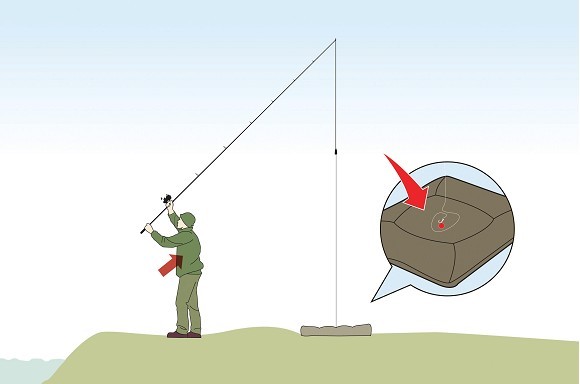
How to cast a Zig Rig
Ever tried to cast a 10ft+ Zig Rig? Nightmare, isn’t it? Here’s CARPology’s guide to doing it with ease
1 Casting off the mat
Only possible when using Zigs of less than around ten-feet. Carefully place the hookbait on the mat ensure the hook can’t catch on the material (you can use PVA foam to protect the hook point), then hold the rod with your arms outstretched above your head giving maximum height. As you lower the rod tip before you cast, a bow of line should be created, ensure no part of the hooklink can catch on anything and then steady the rod so as not to move the hookbait and look forward to cast.
Best for…This technique is perfect for Zig Rig of around 10ft in length. Anything longer, opt for the ‘bucket’ option.
2 Out of a bucket
For fixed Zig Rigs of any length you may find placing the hookbait and excess hooklink inside an empty bucket will help you cast much more easily. Before casting, place the hookbait in the bucket along with the rest of the hooklink and then you can then lean back with confidence and cast as you normally would. Casting from a bucket prevents the hook or hooklink tangling or catching on anything during the cast. This is especially useful in windy conditions when it’s very difficult to stop the hooklink from being moved by the wind before you can cast.
Best for…As above, this works well on fixed Zig Rigs, but is ideal on anything over 10ft long, especially in windy conditions.
3 Taping it up
The other method is to use PVA tape or string in order to prepare the hooklink; this can be helpful for when using long Zig Rigs of over 12ft. Carefully loop up the hooklink, pinching it with thumb and forefinger to hold the loop together and then tie on a piece of PVA tape/string to either side of the loop to hold it in place during the cast. This obviously makes casting much easier, as in essences it’s just like casting out a normal lead set-up with a regular length hooklink, and once in the water the PVA will dissolve and the hookbait should drift up through the water into position.
Best for…Using PVA tape or string to tie up your Zig Rig is perfect for any lengthed Zig, but works a treat on really long Zigs.
The Cast: the do's and don'ts of casting a Zig
Normal Drop
Keep a normal drop (the distance from the lead to the rod tip) with the lead level with the spigot or very slightly shorter. There’s often a temptation when using a Zig to have virtually no drop so more of the hooklink is off the floor just prior to you casting. Unfortunately this technique will often mess up you casting timing, meaning you release the line to late and your lead ends up flying to low, to short and with great speed! The net result of this is a tangled Zig Rig and the lead ‘bombs’ hard into the water.
A normal lengthed drop (i.e. the lead is level with the spigot) will mean you release the line at your normal time (i.e. 11 o’clock on a clock face), achieving a nice levelled trajectory which will gain you maximum distance and prevent tangles.
Check you're clear
Before casting out, ensure whatever technique you are using to cast your Zig, that you have enough clearance from surround trees, bushes or items of tackle to cast it out safely. There is nothing worse than cracking-off on the cast or casting out an entire unhooking mat! You will feel a fool, lose your tackle and not to mention spook the fish.
Prevent a tangle
The last thing you want is, after hours of impatient waiting and seeing fish in the area, for you to wind in and see that your Zig Rig has been sat out there tangled up around the lead clip and tubing. In order to prevent tangles when casting a Zig it’s absolutely crucial that you feather the cast down with your forefinger. This not only slows down the lead but it kicks out the Zig Rig out and prevents it wrapping around the leader and creating a bird’s nest on the cast. Other than that, keep your eyes peeled on the lead and hookbait during the whole of the cast and you should be able to tell if it tangles or not. If you see the hookbait and lead land separately it’s highly unlikely that they tangled.






